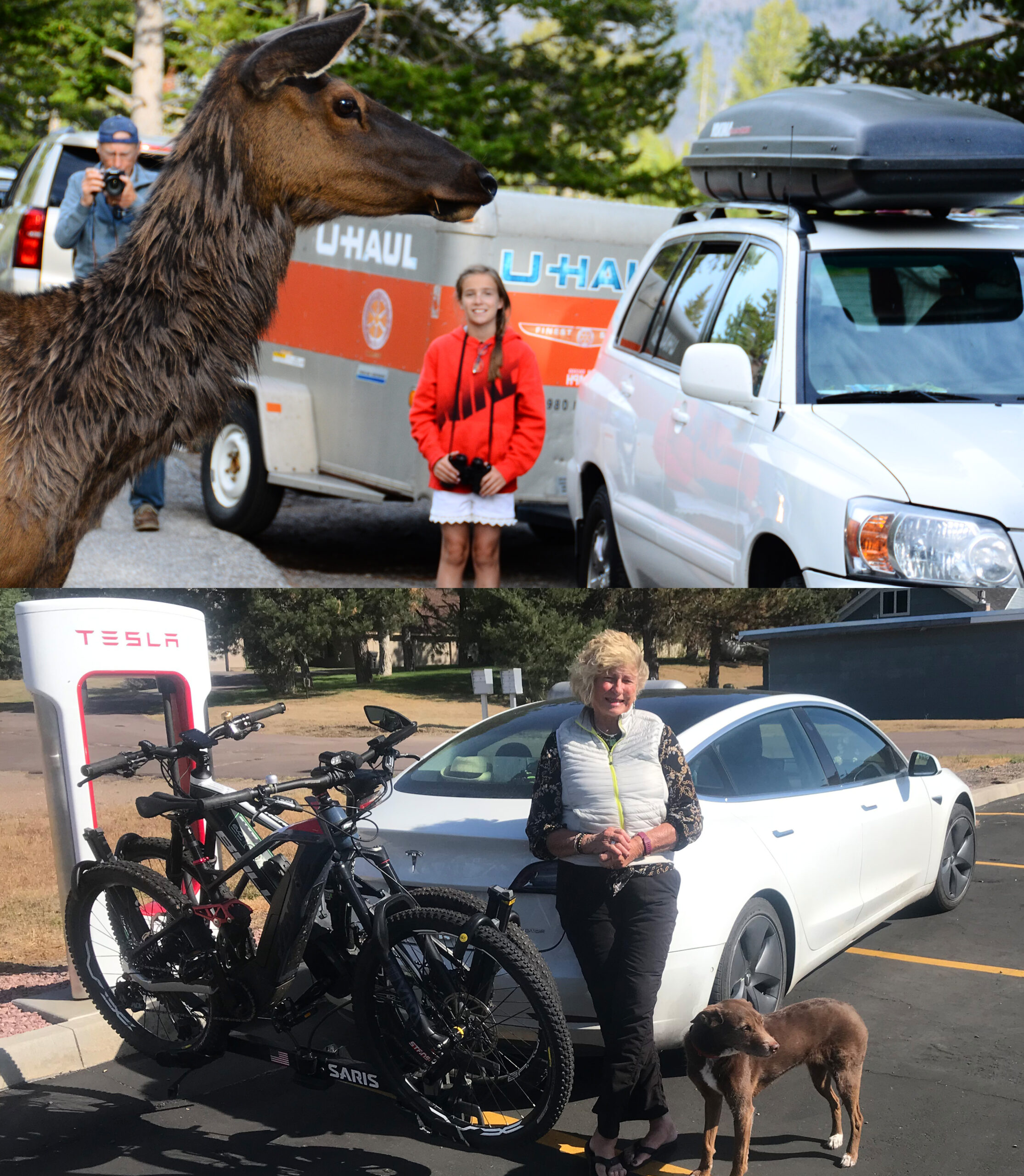Sign up for daily news updates from CleanTechnica on email. Or follow us on Google News!
The Economist is not a publication much given to hyperbole, so when it says the enormous cars and trucks that are held in such high regard by Americans are actually responsible for about half of the highway deaths in the US each year, we should perhaps pay attention and not dismiss its pronouncement as just mere hype and hyperbole.
If you drive in America, the chances are that one in 75 of all the people in the cars around you on the road will be killed by a car — mostly by someone else’s car. Wherever you may be, the folks who are cocooned in a giant SUV or pickup truck are likelier to survive a collision with another vehicle. But the weight of those machines has a cost; it makes the roads more dangerous for everyone else. The Economist has found that, for every life the heaviest 1% of SUVs or trucks saves in America, more than a dozen lives are lost by people riding in smaller vehicles.
Each year, cars kill roughly 40,000 people in America, and not just because it is a big place where people love to drive. The nation’s roads are nearly twice as dangerous per mile driven as those in other developed countries. Deaths in America involving cars and trucks have increased over the past decade despite the introduction of technologies intended to make driving safer.
Heavier Cars & Trucks Are More Dangerous
Weight is to blame, The Economist says. It backs up that claim with data for 7.5 million car crashes in 14 American states between 2013 and 2023. Its study found that for every 10,000 crashes, the heaviest vehicles kill 37 people in the other car, compared with 5.7 for cars of a median weight and just 2.6 for the lightest. The situation is getting worse. In 2023, 31% of new cars in America weighed over 5,000 lb (2.27 tons), compared with 22% in 2018. The number of pedestrians killed by cars has almost doubled since 2010.
Although a typical car is 25% lighter in Europe and 40% lighter in Japan, electrification will add weight there too, exacerbating the gap between the heaviest vehicles and the lightest. The Ford F-150 Lightning weighs around 40% more than its gasoline-powered cousins because of the weight of the battery needed to give it enough range and hauling capacity to compete with conventional pickup trucks. This poses a huge problem. Individually, it is rational for people to buy bigger cars. Yet the result of those individual decisions is many more fatalities as well as more expensive car insurance for all drivers.
The Politics Of Big Cars & Trucks
In theory, regulators could insist that vehicles be made lighter. Good luck with that, The Economist says. Pickup drivers love sitting behind the wheel of a huge truck. Running for election on a platform of banning massive cars would result in a crushing defeat at the polls. The pickup truck today holds the same mystique for Americans, especially males, as did the Marlboro Man in the last century. It is a sign of virility, sexual allure, and personal power that appeals strongly to those who otherwise feel they are powerless. In America, it is hard enough to persuade gun owners to embrace sensible gun laws, because of a belief that guns make people safer. For big cars, that argument is even harder to make, because up to a point, it is actually true.
How can American roads be made safer? As people become aware of the risk their choices impose on everyone else, attitudes to owning gigantic cars may change. The Economist estimates that if the heaviest 10% of vehicles in America’s fleet shrank by roughly 1,000 lb, road fatalities in multi-car crashes would fall by 12%, or 2,300 a year, without sacrificing the safety of the heavier cars.
Attitudes can be nudged with reforms. Bizarrely, the government body that rates cars for safety did not propose taking the safety of pedestrians or other vehicles into consideration until last year. Because of a trade dispute with Europe over exports of poultry, many lighter foreign-made trucks are not even sold in America, a wrinkle known as the “chicken tax.” Tax deductions for working vehicles encourage people to buy heavier trucks with a GWVR of 7000 lb or more. Fuel standards introduced in the 1970s to boost more efficient vehicles gave pickup trucks a carve-out, which inadvertently increased their sales.
How To Make Vehicles Safer
CleanTechnica readers will recognize this as the so-called “footprint rule” that allows bigger, heavier vehicles to meet emissions and fuel economy standards that are significantly lower than those for passenger cars. The trend could tilt in the opposite direction, however. In 2022, France introduced a surcharge on new vehicles of €10 ($11) per kg over 1,800 kg (4,000 lb). In 2023, Norway began taxing car buyers at a rate of NKr12.50 ($1.17) per kg over 500 kg. We are just beginning to see the power of taxation as a policy tool in places like Berkeley, California.
Yet, even if all those things were to change, consumer preferences are so strong that adjustments to fuel efficiency standards would probably not be enough. That suggests another line of attack. In addition to making cars lighter, manufacturers can make accidents less frequent and less deadly. In America, the first step should be to redesign the road system. In the early 1990s, the French were about as likely as Americans to die in a car crash. Now they are three times less likely. Driving in Mississippi is four times as dangerous as in Massachusetts. In both cases, the design of roads explains much of the difference.
It may seem arcane, but the lack of roundabouts in suburban and rural America is a big cause of deaths. Replacing intersections would save thousands of lives a year. The spread of four-lane highways that sit next to shopping malls and mix together pedestrians and cars turning out into heavy traffic is dangerous too. American highway engineers tend to associate wide lanes with safety. In fact, more space encourages people to drive faster.
Slow Down!
A second step that would be relevant everywhere is getting people to slow down. Because the energy — and therefore the destructive power — of a moving vehicle rises with the square of its velocity, finding ways to limit speed has an outsize effect. A good start would be to enforce the laws on speed limits that actually exist, but many American states ban speed cameras. A more ambitious but less popular idea is differential speed limits for cars and trucks depending on weight. Imagine the indignity of being overtaken by a Prius as you sit behind the wheel of your Chevy Silverado pickup, because you must travel 5 mph more slowly to avoid being fined or losing your driving license.
Ultimately, carmakers can innovate away a problem that they have done much to create. Better crash avoidance technology and more pedestrian protection systems would help. True self-driving cars, when they eventually become common, will greatly reduce the number of accidents and hence the death toll, even with heavy vehicles. Unfortunately, The Economist admits, that could be years away. In the meantime, the task of saving lives will fall mainly to road engineers and traffic cops.
The Takeaway
Americans hate small cars. Always have. While Volkswagen was making the Beetle and BMW had its lovely early compact sedans, Americans were driving Cadillacs with trunks large enough for six teenagers to sneak into a drive-in movie theater without paying. When the gas crisis hit in the ’70s, US manufacturers brought smaller cars to market, but many people felt they were being punished by being forced to drive them. David Wilcox wrote a paean to the American automobile that celebrated its enormousness, calling it a tail fin road locomotive — an apt description if ever there was one.
The study by The Economist is important research that might spur some states to consider higher registration fees for heavier vehicles, a policy that would impact electric car drivers the most. What if it cost $500 a year more to register an EV than a similar conventional car because of the weight penalty? EV owners would scream, and yet if they are a greater risk to other motorists, not to mention pedestrians and bicyclists, maybe the idea is worth considering.
Another area that could use some attention is the design for the front of many SUVs and trucks. Many feature high and wide frontal areas that look like the bow of an oil tanker bearing down on anyone unlucky enough to get in their way. It seems intuitively obvious that designers are making the front of today’s cars and trucks look as aggressive as possible to massage the egos of those who find themselves behind the wheel of these massive vehicles. Powerful vehicles for those who feel powerless in a world where change happens much faster than it ever did before? Absolutely.
We have at least one CleanTechnica reader who advocates tirelessly for smaller, lighter, more efficient cars and trucks. Is America ready to accept the downsizing of its vehicles to save lives? If history is any guide, the answer is an emphatic no.
Have a tip for CleanTechnica? Want to advertise? Want to suggest a guest for our CleanTech Talk podcast? Contact us here.
Latest CleanTechnica.TV Videos
CleanTechnica uses affiliate links. See our policy here.
CleanTechnica’s Comment Policy




